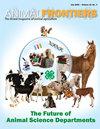欧洲农民在精准畜牧业系统方面的经验
IF 3.2
2区 农林科学
Q1 AGRICULTURE, DAIRY & ANIMAL SCIENCE
引用次数: 22
摘要
自20世纪70年代以来,随着现代牲畜生产系统的出现,每个农场的牲畜数量急剧增加,世界范围内的牲畜产量增长了四倍。由于世界人口对动物源性食品的需求快速增长,猪和禽肉的产量在过去30年中翻了一番(粮农组织,2006年)。世界肉牛、猪和家禽市场的产量从1961年的约6000万吨增加到2010年的约2.8亿吨(粮农组织,2006年)。2012年全球鸡肉产量明显超过1亿吨(粮农组织,2014年)。到2030年,预计家禽、猪肉和牛的肉类总产量约为3.5亿吨(粮农组织,2006年)。这种巨大的增长只有通过育种方面的重大进步和专业化农场的发展才有可能实现,这些农场拥有现代化的、集约化的、通常是非放牧生产系统,在这种生产系统中,动物以高放养率被关在密闭的房子里。这些系统充分利用了动物所选择的遗传品质,使它们能够在适当的住房、喂养、卫生、管理和兽医控制下,在尽可能短的时间内达到高生长速度和高饲料效率。例如,蛋鸡的产蛋效率从1960年的160个蛋提高到2011年的300多个蛋。今天,在欧盟,每年大约有3.6亿只红肉动物和数十亿只鸡被屠宰。在世界范围内,每年大约有600亿只动物被屠宰作为食物。1960年至1980年间,德国一个地区的蛋鸡数量增加了近12倍,从20万只增加到1200万只,而蛋鸡养殖场(拥有3000多只母鸡)的数量下降到几百只(科隆和温德霍斯特,2001年;文德霍斯特,2006)。在德国,虽然每个农场的动物数量增加了,但农场数量却减少了,以农民为生的人数下降到2%左右。德国目前仅1355个农场就饲养着3850万只蛋鸡(Destatis, 2014)。与此同时,农畜产品价格停滞不前或有所下降。从统计数据可知,德国消费者在食品上的相对支出从1900年的57%下降到2010年的14% (Statista, 2012)。在人类历史上,欧洲人第一次不需要担心足够的食物供应(Hartung, 2013)。并非世界各地的情况都是如此。自1990年以来,世界人口增长了30%,预计到2050年将达到96亿人。预计到那时,70%的世界人口将生活在城市地区,而1990年这一比例为40%,目前约为50% (Mottet,未发表)。尤其是欧洲农民在精准畜牧业系统方面的经验本文章由计算机程序翻译,如有差异,请以英文原文为准。
European farmers’ experiences with precision livestock farming systems
With the advent of modern livestock production systems since the 1970s, the numbers of animals per farm increased dramatically, and worldwide livestock production has grown by a factor of four. The production of pig and poultry meat has doubled in the last 30 yr following the demand of a fast-growing world population for food of animal origin (FAO, 2006). The output of the world meat market for cattle, pig, and poultry rose from about 60 million tons in 1961 to about 280 million tons 2010 (FAO, 2006). Chicken meat production worldwide has reached in 2012 clearly more than 100 million tons (FAO, 2014). For 2030, a total meat production of poultry, pork, and cattle of about 350 million tons is expected (FAO, 2006). This enormous increase was only possible by significant breeding progress and the development of specialized farms with modern, intensive, and very often non-grazing production systems where the animals are kept in confined houses at high stocking rates. These systems make best use of the animals’ selected genetic qualities that enable them, under appropriate housing, feeding, hygiene, management, and veterinary control, to reach high growth rates and high feed efficiencies in the shortest possible time. As an example, the efficiency of egg production of laying hens rose from 160 eggs in year 1960 to more than 300 eggs in 2011. Today, about 360 million red meat animals are slaughtered in the European Union (EU) per year along with several billions of chicken. Worldwide, about 60 billion animals are slaughtered for food per year. The number of laying hens in one district of Germany rose between 1960 and 1980 by a factor of nearly 12 from a couple of hundred thousand to 12 million while the number of laying hen farms (with more than 3,000 hens) dropped to a couple of hundred (Klon and Windhorst, 2001; Windhorst, 2006). While the number of animals per farm increased, the number of farms decreased and the number of people making their living as farmers dropped to about 2% in Germany. The 38.5 million laying hens are kept in Germany today on 1,355 farms only (Destatis, 2014). At the same time, the prices of farm animal products stagnated or decreased. From statistical figures, it is known that the relative expenditure of consumers in Germany of their income for food dropped from 57% in 1900 to 14% in 2010 (Statista, 2012). For the first time in human history, Europeans do not need to worry about sufficient food supply (Hartung, 2013). This is not the case in all parts of the world. World population rose by 30% since 1990 and is estimated to reach 9.6 billion people who have to be fed in 2050. It is expected that then 70% of the world population will live in urban areas, which is up from 40% in 1990 and about 50% today (Mottet, unpublished). Not least European farmers’ experiences with precision livestock farming systems
求助全文
通过发布文献求助,成功后即可免费获取论文全文。
去求助
来源期刊

Animal Frontiers
Veterinary-Food Animals
CiteScore
6.50
自引率
5.60%
发文量
74
期刊介绍:
Animal Frontiers is the official journal of the following globally active professional animal science societies:
ASAS, the American Society of Animal Science
CSAS, the Canadian Society of Animal Science
EAAP, the European Federation of Animal Science
AMSA, the American Meat Science Association
These organizations are dedicated to the advancement and dissemination of science-based knowledge concerning animal agriculture. Animal Frontiers provides a novel forum for innovative and timely perspectives that have relevance to understanding the complex dynamics at work through animal agriculture. Animal Frontiers publishes discussion and position papers that present several international perspectives on the status of high-impact, global issues in animal agriculture. Every issue will explore a theme of broad and current interest within animal science and animal agriculture.
 求助内容:
求助内容: 应助结果提醒方式:
应助结果提醒方式:


